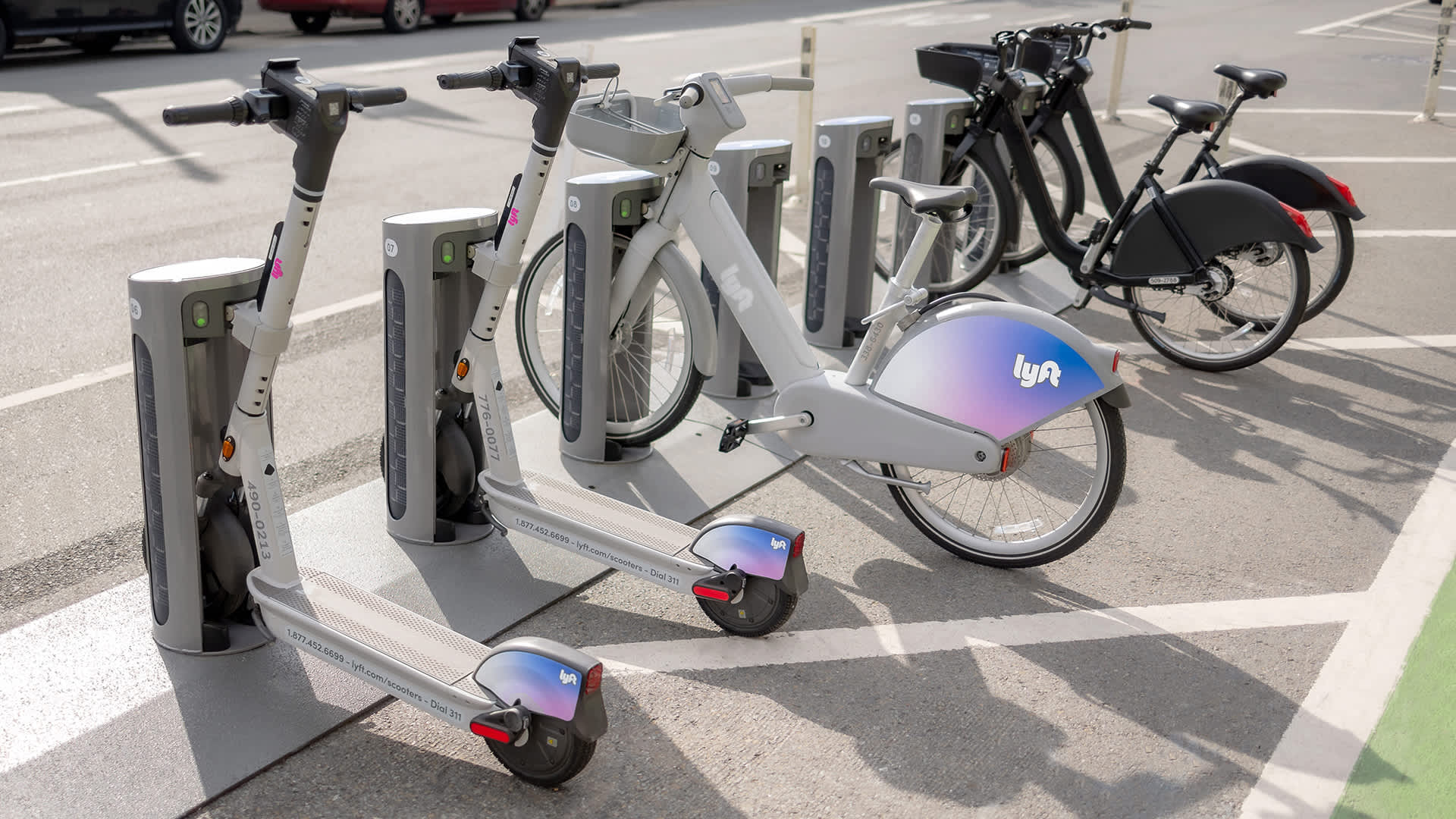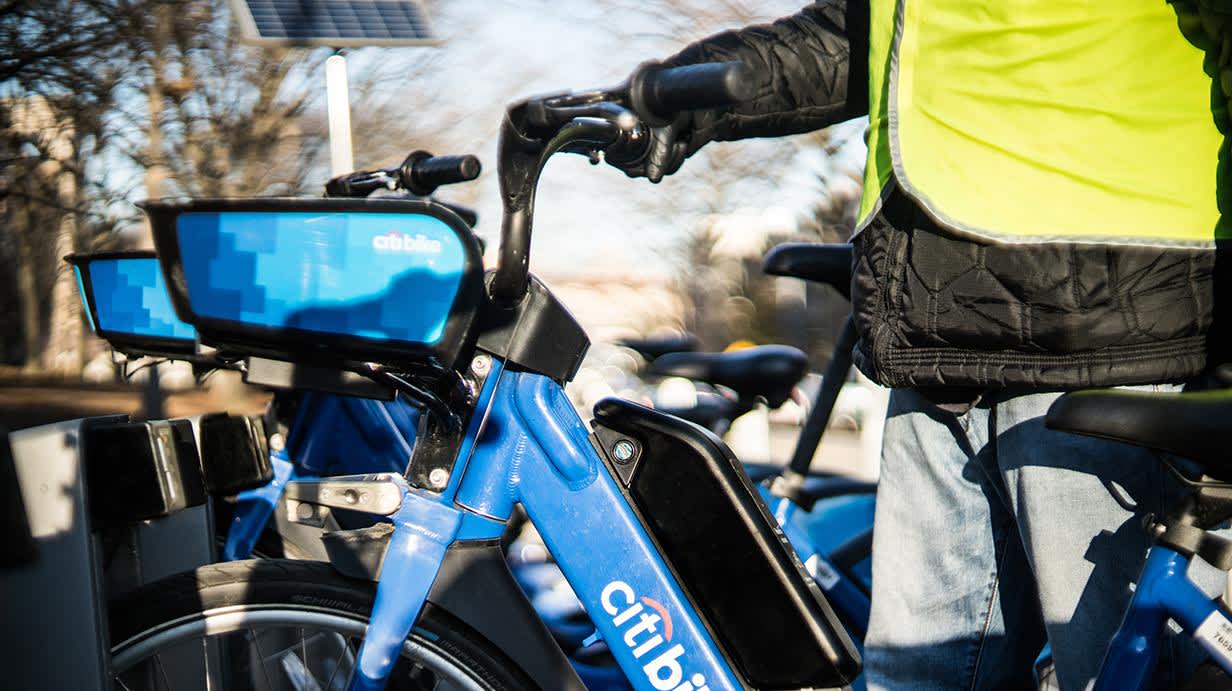
There is little doubt that ebikes can supercharge a bikeshare program. In New York City, ebikes currently comprise roughly one-fifth of the total Citi Bike fleet but typically account for as many as half of all rides.
Ebikes add a twist to the already complex logistics of bikeshare: Unlike pedal bikes, they need to be recharged. Some systems navigate the challenge by deploying teams of people, and vehicles, to the city streets to bring fresh batteries to bikes — a costly, carbon-emitting endeavor.
That’s what makes so-called “in-dock charging” stations, where the docks themselves can charge the bikes, so attractive. Switching to electrified stations, notes Carlos Valadao, Lyft’s senior station operations manager, comes with an outsize effect. “Our modeling in Chicago shows that if we electrify as little as 15% to 20% of our stations, we could keep as much as 80% of the fleet charged — and reduce our battery-swap costs by 80% and annual greenhouse gasses by 50 tons.”
Small wonder that European cities — like Barcelona, which has more than 500 electrified stations on its streets — have so readily embraced the technology.
In the U.S., however, cities looking to expand their ebike offerings and roll out in-dock charging face one hurdle that their European counterparts don’t: cost. As a report from the Transit Costs Project notes, “the United States has among the highest transit-infrastructure costs in the world.”
In New York City, notes Miller Nuttle, Lyft’s director of micromobility and transit policy, the act of “trenching” — digging up the street to run a cable from a power source to a bikeshare station — can cost between $70,000 and $100,000. Moreover, building an electrified station means navigating not only the complex regulatory web of the utility company but also the Department of Buildings and the Department of Transportation. “Then we have to hire a third-party contractor that’s a certified engineer to carry out all that work,” he says.
Nevertheless, many American cities remain motivated to electrify their stations — and are partnering with the private sector to help them find a path forward. In 2019, after Lyft began managing Chicago’s Divvy bikeshare system, the company aimed to not only expand the city’s system but also convert a number of stations to in-dock charging. The plan, notes Valadao, quickly ran up against the financial realities, particularly in dense areas like the city’s Loop. “The cost was pretty eye-opening,” says Valadao. Lyft opted to begin with a five-station trial, which it debuted in May 2022 — making Chicago the first U.S. bikeshare system to implement in-dock charging.
Meanwhile, the public policy team got to work with city partners on finding an avenue for funding future stations. Working with ComEd, the Illinois utility provider, the Chicago Department of Transportation was able to tap into public funds set aside for sustainability initiatives to bring power from the grid to the station sites. Lyft is also exploring partnerships with a digital ad panel partner, which will fund the design, permitting, and construction of another round of stations in exchange for outdoor advertising rights.
The public policy team is also exploring the possibility of accessing the funding stream for electric vehicles unlocked last year by President Biden’s Inflation Reduction Act. While much of that is earmarked for electrifying highways, a $2.5 billion tranche is subject to competitive charging infrastructure grants for cities, towns, and tribal communities — and while the phrasing says “electric vehicles,” there’s nothing, according to Nuttle, that precludes some of that going to electrifying bikeshare, so long as it’s co-located with traditional EV infrastructure. This potential funding source could particularly help cities like San Francisco and New York City, which are currently experimenting with in-dock charging for private ebike owners and shared ebike fleets.
Pittsburgh, thanks to its nimble regulatory landscape, is further ahead — and setting a precedent for other cities to follow. Sara Khalil, director of operations for Bike Share Pittsburgh, says the nonprofit worked together with other shared services — like Zipcar — to make electrification, for all kinds of transportation modes, a priority. “We all have different goals, but the main thing that came out of that coalition was we need charging in-field,” she says. “We don’t want to jump through hoops and pay $50,000 every time.” She credits the city for really listening and Duquesne Light Company, the utility provider, for allowing the system to plug the electrified stations (which comprise one-third of the total network) into the existing streetlight network. Pittsburgh, she notes, pays a flat rate for streetlights, so Bike Share Pittsburgh had to work out a deal to pay the utility appropriately for the increased demand for electricity. It took some flexibility and innovative thinking, but, in the end, it paid off.
The electrified stations, she says, have been “mind-blowing.” One result is that members no longer have to pay a premium for ebikes. “The reason we’re able to do that is because we have in-field charging,” Khalil says. “If we had to be touching all those bikes — just all that extra cost and labor — we wouldn’t be able to do that.”
Down the road, systems may roll out electrified stations, powered by solar, that don’t even have to tap into the grid. Frederic Elias, an engineering manager at Lyft, notes that canopies with solar arrays would provide not only power but also shade for people and bikes (when batteries get too hot, they stop charging — think of your smartphone when it’s been in the sun).
But, as Pittsburgh proves, technological advances are not enough. Getting electrified bikeshare stations onto our streets — and more people opting for this sustainable mode of transport — will take policymakers and industry collaborating and innovating together.


